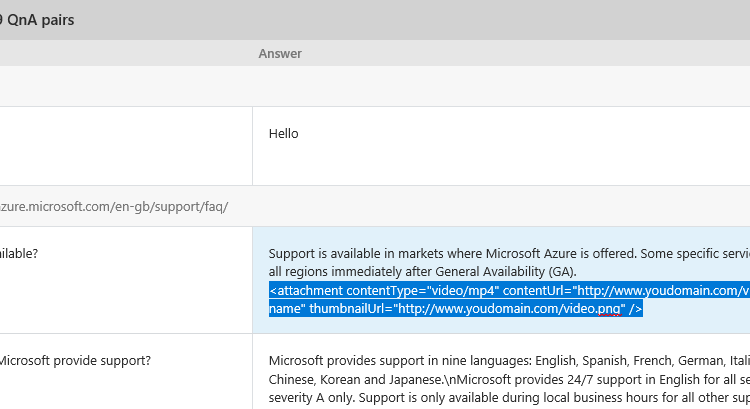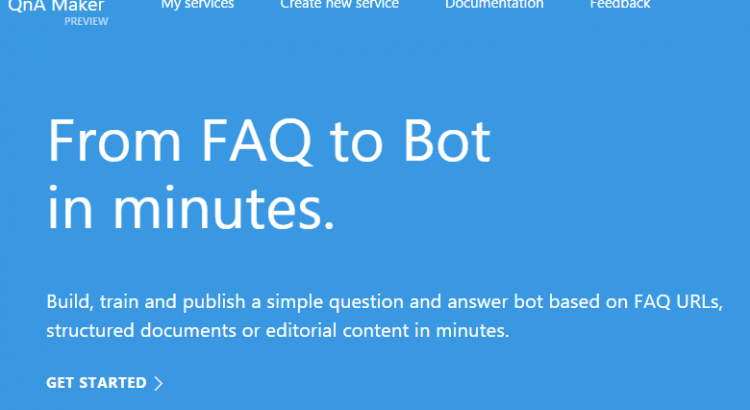I am pleased to announce the release of an updated version of the QnAMaker Dialog, allowing you to hook up a Bot Framework Bot and QnAMaker easily, and a brand new open source project, QnAMaker Sync Library, allowing you to sync an external data source to QnAMaker in a snap!
So, let’s look at the two new releases in a little more detail;
QnAMaker Dialog v3
GitHub -> https://github.com/garypretty/botframework/tree/master/QnAMakerDialog
NuGet -> https://www.nuget.org/packages/QnAMakerDialog/
If you haven’t seen the QnAMaker Dialog before, it allows you to take the incoming message text from the bot, send it to your published QnA Maker service, get an answer and send it to the bot user as a reply automatically. The default implementation is just a few lines of code, but you can also have a little more granular control over the responses from the dialog, such as providing different responses depending on the confidence score returned with the answer from the service.
In the new v3 release, a couple of really significant improvements have been made.
The dialog is now based on v3 of the QnAMaker API (previously it was v1), meaning that when you query your QnAMaker service with the dialog you can now get more than one answer back if multiple answers are found. This means that for queries which return multiple answers with similar confidence scores, you can potentially offer your user’s a choice of which answer is the best fit for them.
Secondly, v3 of the QnAMaker Service supports the addition of metadata to the items in your knowledgebase and the ability to use this metadata to either filter or boost certain answers. The metadata is just one or more key/value string pairs, so you can add whatever information you like. e.g. you might add a metadata item called ‘Category’ and set an appropriate value for each answer, which you can then filter on when querying the service to provide a more targeted experience for your users. The new QnAMaker Dialog release now uses this metadata and allows you to specify metadata items for both filtering and boosting.
More details about the QnAMaker dialog, including code samples for the new features are available over on GitHub.
QnAMaker Sync Library
GitHub -> https://github.com/garypretty/qnamaker-sync
NuGet -> https://www.nuget.org/packages/QnAMakerSync/
When you create a QnAMaker service, you can populate your knowledgebase in a few different ways – manually, automatically extract FAQs from a web page, or upload a tab separated file. However, many of you will already have your FAQ data held somewhere else, such as on your web site in your CMS or maybe within a CRM system. What happens when you update the information in your other system? You probably need to go and manually update the knowledgebase in your QnAMaker service too, which isn’t great. Added to this is the fact that behind the scenes (as mentioned above in the QnAMaker Dialog section), the QnAMaker service supports adding metadata to your QnA data to help you filter or boost certain answers when querying the service. The big problem right now though is that the QnAMaker portal doesn’t yet support the latest APIs and therefore you can’t add metadata through the UI.
So, what do you do? Well, there are a set of APIs available for you to manage your knowledgebase, which includes metadata support, so you could go and write some code to integrate QnAMaker with your web site or repository – but there is no need now, because the QnAMaker Sync Library should hopefully have you covered!
The C# library allows you to simply write just the code needed to get your QnA items from wherever they are (e.g. FAQ pages on your site) and use them to build a list of QnAItems (a class included in the library). Once you have this list, you then simply pass it to the QnAMaker Sync library (along with your knowledgebase and subscription ID) and voila, your data will be pushed into the QnAMaker service. What’s more, when you build the list of QnAItems, you pass a unique reference for each item so that it can be identified in your original repository (e.g. a page ID from your web site) and these references are used the next time we sync so that we know which items to update and which to delete.
Full details as well as code samples are available over on GitHub and the library is now available via NuGet as well.



